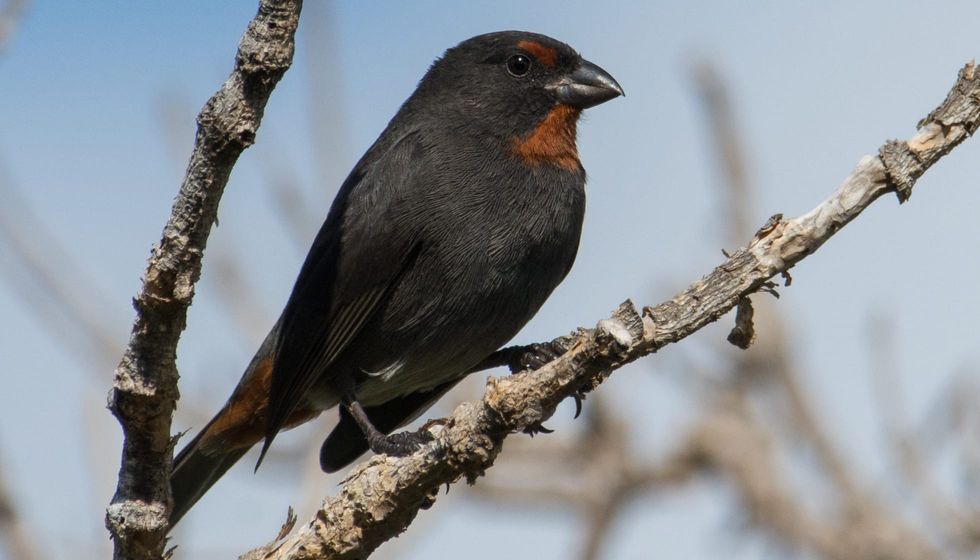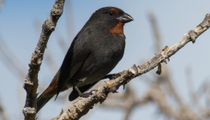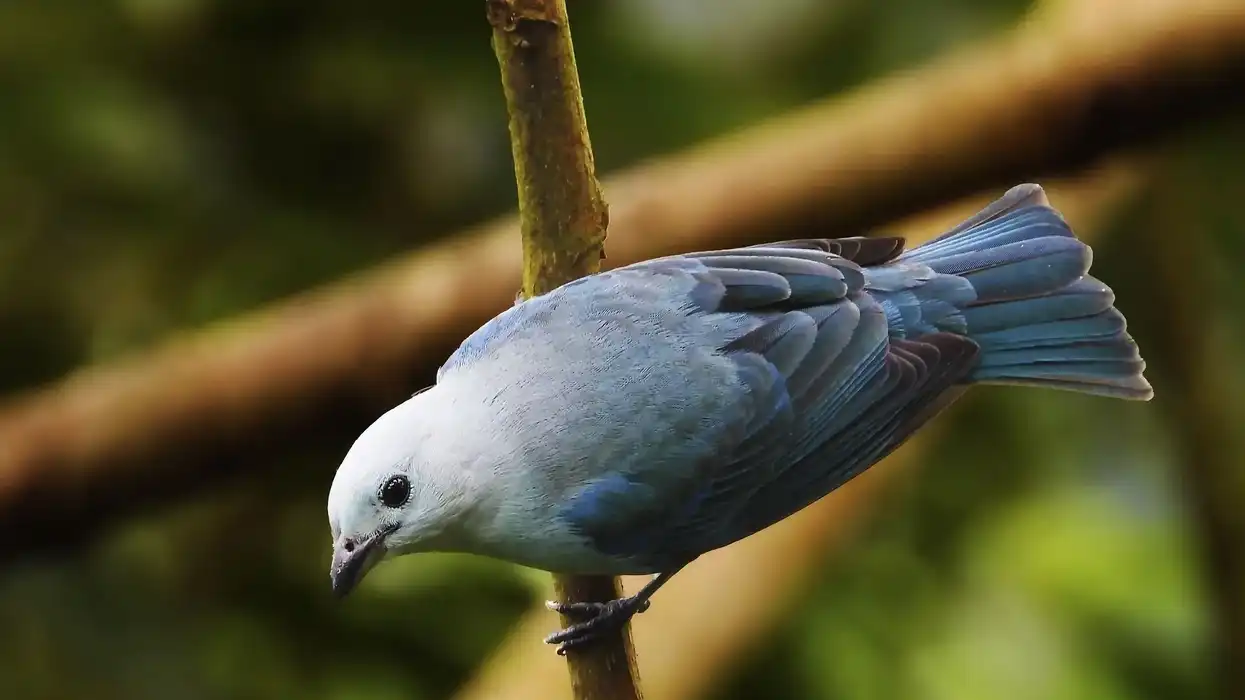The Greater Antillean bullfinch (scientific name: Melopyrrha violacea, synonym: Pyrrhulagra violacea) is a neotropical bird species of the family Thraupidae.
A perching bird of the order Passeriformes, the Greater Antillean bullfinch is a secretive inhabitant of dense thickets and undergrowths. Its natural habitats range from tropical or subtropical dry shrublands to tropical dry and moist forests and even montane forests.
These birds have a widespread distribution in the islands of the West Indies, including the north and the central Bahamas, Jamaica, Hispaniola (Haiti and the Dominican Republic), and the Turks and Caicos Islands.
When it comes to aesthetics, the Greater Antillean bullfinch is quite the visual treat (if you are lucky enough to spot it!). These birds of the West Indies have an overall dark gray to black plumage with an orange-red throat and eyebrows.
Otherwise quite enigmatic, the Greater Antillean bullfinch is more easily heard than seen. The bird's song comprises high-pitched, repeated trills followed by insect-like buzzing. Currently, the bird has five recognized subspecies.
Read on if you want to know more about the Greater Antillean bullfinch! For more relatable content, check out these yellow-breasted finch facts and purple finch facts for kids.
Greater Antillean Bullfinch Interesting Facts
What type of animal is a Greater Antillean bullfinch?
The Greater Antillean bullfinch (Melopyrrha violacea) is a perching bird species of the family Thraupidae.
What class of animal does a Greater Antillean bullfinch belong to?
The Greater Antillean bullfinch (Melopyrrha violacea) belongs to the class of birds (class Aves).
How many Greater Antillean bullfinches are there in the world?
An estimate of the total population size of the Greater Antillean bullfinch (Melopyrrha violacea) is not available.
Where does a Greater Antillean bullfinch live?
The Greater Antillean bullfinch habitat range includes most islands of the West Indies surrounded by the Caribbean Sea and the North Atlantic Ocean. The species (and its subspecies) has a widespread distribution in the north and the central Bahamas, Hispaniola (Haiti and the Dominican Republic) and surrounding islands, Tortue Island off northwest Hispaniola, Turks and Caicos Islands, and Jamaica.
The birds can be found from sea level to elevations of up to 6,562 ft (2,000 m).
What is a Greater Antillean bullfinch's habitat?
The Greater Antillean bullfinch (Melopyrrha violacea) is found in a diverse range of habitats. The bird species are common in dense thickets and undergrowths in tropical or subtropical moist lowland forests, dry forests, dry shrublands, moist montane forests, gardens, and pine woods.
Who do Greater Antillean bullfinches live with?
The Greater Antillean bullfinch birds may be seen foraging individually or in small groups.
How long does a Greater Antillean bullfinch live?
According to the British Trust for Ornithology, the average lifespan of a Eurasian bullfinch of the genus Pyrrhula is two years. The lifespan estimate of the Greater Antillean bullfinch species is not available.
How do they reproduce?
Very limited information is available regarding the breeding behavior of the Greater Antillean bullfinch. The birds lay eggs around March-June. The breeding nest is mostly like a cup, spherical, with an entrance on the side.
The birds place their nest in shrubs, clumps of grass, tree cavities, or on branches of trees and line them with fine material such as pieces of bark, twigs, leaves, or bromeliads. A female bird lays a clutch of three to four eggs. The eggs are pale bluish-white, with thin yellowish-brown or reddish-brown marks.
What is their conservation status?
According to the International Union for Conservation of Nature (IUCN) Red List of Threatened Species, the Greater Antillean bullfinch (Melopyrrha violacea) is a species of Least Concern. The bird is common in Jamaica, the island of Hispaniola, and the Bahamas.
Greater Antillean Bullfinch Fun Facts
What do Greater Antillean bullfinches look like?

We've been unable to source an image of a Greater Antillean bullfinch and have used an image of a yellow-throated euphonia instead. If you are able to provide us with a royalty-free image of a Greater Antillean bullfinch, we would be happy to credit you. Please contact us at hello@kidadl.com.
The Greater Antillean bullfinch has a sturdy build. The male birds of the species have an overall black plumage with vivid, red-orange throat, under tail coverts, and eyebrow stripes.
The dark gray bill is quite thick. Their legs are dusky, with toes ideally designed for perching.
The female birds of the species are more or less similar to their male counterparts but with a duller, more slaty version of the male's black plumage. The juvenile birds are more like the female of the species, but with brown upper parts and reduced reddish-orange markings on the throat.
How cute are they?
The small size and stout build give the Greater Antillean bullfinch an adorable look. However, the fiery red eyebrow stripes and throat against the dark plumage make the birds look more smart and elegant.
How do they communicate?
The Greater Antillean bullfinch is quite the vocal bird that communicates through songs and calls. The typical song of the bird is a high-pitched series of 't’zeet t’zeet t’seet t’seet seet seet seet', and the call comprises individual spit notes.
How big is a Greater Antillean bullfinch?
The Greater Antillean bullfinch is a small-sized bird measuring between 5.2-6.9 in (13.2-17.5 cm). The birds are about the same size as the Eurasian bullfinch (Pyrrhula pyrrhula).
How fast can a Greater Antillean bullfinch move?
The exact speed of the Greater Antillean bullfinch is unknown.
How much does a Greater Antillean bullfinch weigh?
The Greater Antillean bullfinch weighs between 0.6-1.1 oz (17-31.2 g).
What are the male and female names of the species?
Male and female bullfinches do not have sex-specific names.
What would you call a baby Greater Antillean bullfinch?
Like most other birds, a baby Greater Antillean bullfinch would be called a chick.
What do they eat?
The Greater Antillean bullfinch primarily feeds on seeds, fruits, and flowers. Snails also form a part of their diet.
Are they dangerous?
The Greater Antillean bullfinch is a harmless bird with no known record of being dangerous. It is a rather secretive species and would most probably avoid contact with humans.
Would they make a good pet?
It is not advisable to keep a wild bird like the Greater Antillean bullfinch as a pet.
Did you know...
In zoological nomenclature, a synonym is an alternative to a different scientific name and cannot exist in isolation. In the case of the Greater Antillean bullfinch, the scientific name of the bird is Melopyrrha violacea, but the synonymous name is Pyrrhulagra violacea.
Swedish naturalist Carl Linneaus described the Greater Antillean bullfinch in 1758. Back then, he described the bird under the name Loxia violacea.
In Linneaus's description of the Greater Antillean bullfinch under the name Loxia violacea, the specific epithet violacea is a Latin word that translates to violet-colored. It was an extrapolation of Mark Catesby's 1731 description and illustration of the bird as the purple grossbeak.
The Greater Antillean was formerly placed in the genus Loxigilla. However, later studies conducted in 2014 placed the Puerto Rican bullfinch and the Greater Antillean bullfinch in the genus Melopyrrha.
The type locality of the Greater Antillean bullfinch is the Bahamas. In biology, a type is a specimen organism that represents the defining characteristics of the particular taxon. Naturally, the type locality is the place where the type specimen is found.
Birds of the family Tharupidae are called tanagers. The family has several genera, species, and subspecies, including some popular birds such as the western tanager, summer tanager, and Darwin's finches.
What is the Greater Antillean bullfinch's range?
The Greater Antillean bullfinch range spans the various islands of the West Indies, with the five subspecies of the bird occupying distinct regions.
M. v. violacea is found in the north, and the central Bahamas, M. v. ofella is from the central and east Turks and Caicos Islands of the southern Bahamas, M. v. affinis is found in Hispaniola, M. v. maurella is widespread in the Tortue Island off northwest Hispaniola, and M. v. ruficollis has a prominent distribution in Jamaica.
The Greater Antillean bullfinch's voice
The Greater Antillean bullfinch voice is high-pitched, thin, and raspy. The bird's song sounds like an insect's buzz, a repeated trill of notes 't’zeet t’zeet t’seet t’seet seet seet seet'.
Here at Kidadl, we have carefully created lots of interesting family-friendly animal facts for everyone to discover! Learn more about some other birds from our elegant tit interesting facts and rufous babbler facts for kids pages.
You can even occupy yourself at home by coloring in one of our free printable long-tailed finch coloring pages.
Main image Dominic Sherony.
Second image by Ron Knight.









